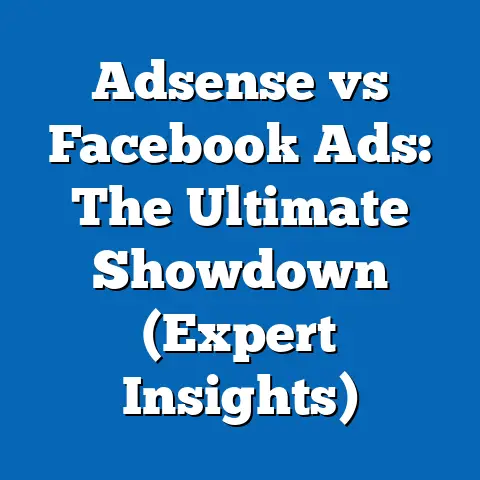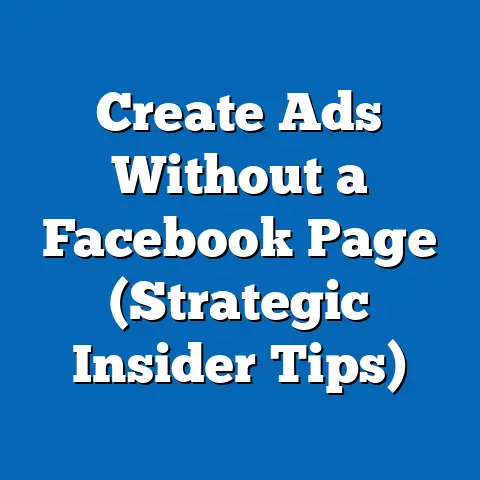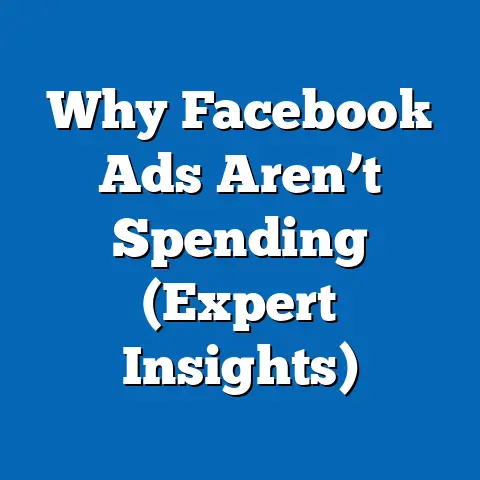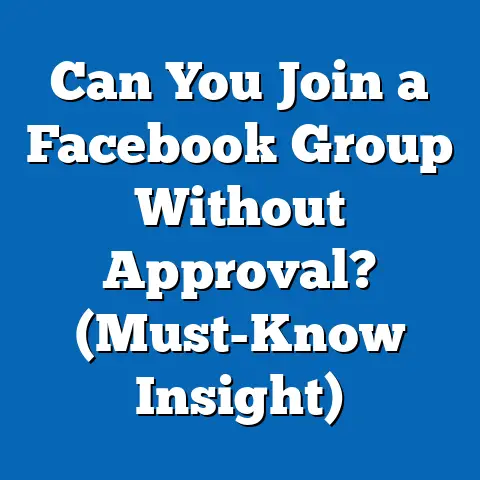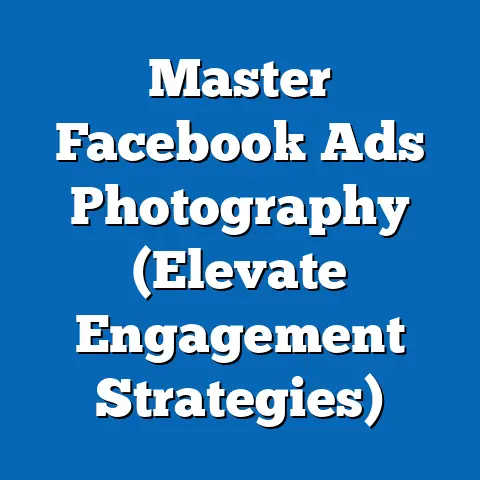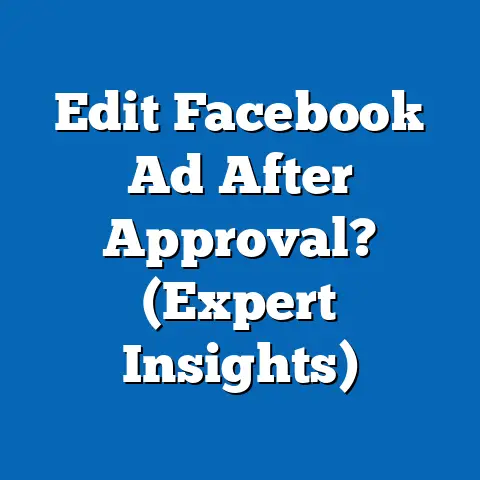Unlock Email Connections with Facebook Lead Ads (Expert Guide)
Craftsmanship in digital marketing is an art form, a delicate balance of precision, creativity, and technique. It’s about more than just throwing money at ads; it’s about carefully planning and executing strategies that truly resonate with your target audience. And when it comes to capturing leads and building meaningful connections, Facebook Lead Ads, combined with a robust email marketing strategy, can be a powerful tool in your arsenal.
I’ve spent years honing my skills in Facebook advertising, and I’ve seen firsthand how a well-crafted Lead Ad can transform a business. But simply collecting email addresses isn’t enough. The real magic happens when you nurture those leads through personalized email campaigns, turning them into loyal customers.
In this guide, I’ll share my expert insights on how to unlock the full potential of Facebook Lead Ads and email marketing. We’ll dive deep into crafting compelling ads, seamlessly integrating email collection, and nurturing leads through targeted email sequences. By the end of this article, you’ll have a clear understanding of how to leverage these tools to enhance your customer relationships and drive conversions.
Understanding Facebook Lead Ads
Facebook Lead Ads are a game-changer in the world of digital marketing. Unlike traditional ads that redirect users to an external landing page, Lead Ads allow users to submit their information directly within the Facebook platform. This seamless user experience is what makes them so effective for capturing leads.
Think about it: how many times have you clicked on an ad, only to be redirected to a slow-loading website with a clunky form? It’s frustrating, right? Lead Ads eliminate that friction, making it incredibly easy for users to provide their contact information.
Here’s how they work:
- User Sees the Ad: A user scrolling through their Facebook feed sees your compelling Lead Ad.
- Clicks the Call to Action: Intrigued by your offer, they click the call-to-action button (e.g., “Sign Up,” “Learn More,” “Get a Quote”).
- Form Pops Up: A pre-populated form appears, pulling information directly from the user’s Facebook profile (name, email, phone number, etc.).
- User Submits: With just a tap or two, the user submits their information without ever leaving Facebook.
This streamlined process significantly increases conversion rates compared to traditional landing pages. According to Facebook, Lead Ads have been shown to generate leads at a lower cost per lead than other advertising methods.
Why are Lead Ads so effective?
- Mobile-Friendly: They are designed for mobile devices, which is where most Facebook users spend their time.
- Seamless Experience: The in-platform experience eliminates friction and makes it easy for users to submit their information.
- Pre-Populated Forms: Forms are pre-populated with information from the user’s Facebook profile, saving them time and effort.
- Targeted Audience: You can target your Lead Ads to specific demographics, interests, and behaviors, ensuring that you reach the right people.
Real-World Example:
I once worked with a local real estate agent who was struggling to generate leads through traditional advertising methods. We implemented a Facebook Lead Ad campaign targeting potential homebuyers in the area. The ad featured stunning photos of available properties and offered a free guide to buying a home. Within just a few weeks, we generated hundreds of qualified leads at a fraction of the cost of their previous advertising efforts.
Takeaway: Facebook Lead Ads are a powerful tool for capturing leads due to their seamless user experience and mobile-friendly design.
The Importance of Email Marketing
In the ever-evolving landscape of digital marketing, email marketing remains a cornerstone strategy for businesses of all sizes. While social media platforms and search engines grab headlines, email offers a direct line of communication with your audience, fostering deeper relationships and driving higher conversion rates.
I’ve seen countless businesses underestimate the power of email marketing, focusing solely on social media or paid advertising. But the truth is, email marketing provides a level of control and personalization that other channels simply can’t match.
Why is building an email list crucial?
- Direct Communication: You own your email list, unlike social media followers who can be affected by algorithm changes or platform policies.
- Personalization: You can segment your email list and send targeted messages based on demographics, interests, and behaviors.
- High ROI: Email marketing consistently delivers one of the highest returns on investment compared to other marketing channels. Studies have shown that for every $1 spent on email marketing, businesses can expect an average return of $42.
- Building Relationships: Email allows you to nurture leads, build trust, and establish yourself as an authority in your industry.
- Driving Conversions: Email is a powerful tool for driving sales, promoting events, and announcing new products or services.
The Synergy Between Facebook Lead Ads and Email Marketing
Facebook Lead Ads are the perfect way to grow your email list quickly and efficiently. By capturing leads directly within the Facebook platform, you can bypass the need for external landing pages and streamline the signup process.
But the real magic happens when you combine Lead Ads with a well-crafted email marketing strategy. Once you’ve captured a lead through a Lead Ad, you can then nurture them through a series of personalized email campaigns, guiding them further down the sales funnel.
Here’s how it works:
- Lead Ad Captures Email: A user submits their email address through your Facebook Lead Ad.
- Email Added to List: The email address is automatically added to your email marketing platform (e.g., Mailchimp, HubSpot).
- Welcome Email Sent: A welcome email is automatically sent to the new subscriber, thanking them for signing up and providing valuable information.
- Targeted Email Sequence: The subscriber is added to a targeted email sequence based on their interests or demographics.
- Nurturing and Engagement: You continue to nurture the lead through valuable content, special offers, and personalized messages.
Real-World Example:
I helped a local fitness studio grow their email list by running a Facebook Lead Ad campaign offering a free trial class. We then set up an automated email sequence that welcomed new subscribers, provided information about the studio’s classes, and offered a special discount on membership. As a result, they saw a significant increase in new members and revenue.
Takeaway: Email marketing is a crucial component of any digital marketing strategy, and Facebook Lead Ads are a powerful tool for growing an engaged email list.
Crafting Compelling Lead Ads
Creating a high-converting Facebook Lead Ad is an art form. It requires a combination of attention-grabbing visuals, persuasive copy, and a clear call to action. I’ve seen firsthand how small tweaks to an ad can make a huge difference in its performance.
Here are the essential components of a compelling Lead Ad:
- Attention-Grabbing Headline: Your headline is the first thing people will see, so it needs to be captivating and relevant. Use strong verbs, numbers, and questions to pique their interest.
- Persuasive Copy: Your ad copy should clearly explain the benefits of your offer and why people should sign up. Focus on solving their problems and addressing their pain points.
- Eye-Catching Images: Use high-quality images or videos that are visually appealing and relevant to your offer. Make sure your visuals are optimized for mobile devices.
- Clear Call to Action: Tell people exactly what you want them to do (e.g., “Sign Up Now,” “Download Your Free Guide,” “Get a Quote”). Use a strong call-to-action button that stands out from the rest of the ad.
- Value Proposition: Clearly communicate the value that people will receive by signing up. What problem will you solve for them? What benefits will they experience?
Tips for Creating Value Propositions That Resonate:
- Understand Your Audience: Know their needs, wants, and pain points.
- Focus on Benefits, Not Features: Explain how your offer will improve their lives.
- Be Specific: Avoid vague statements and use concrete examples.
- Highlight What Makes You Unique: What sets you apart from the competition?
Examples of Successful Lead Ad Campaigns:
- Airbnb: Airbnb ran a Lead Ad campaign offering a free travel guide to specific cities. The ad featured stunning photos of the city and highlighted the benefits of using Airbnb for accommodation.
- HubSpot: HubSpot ran a Lead Ad campaign offering a free marketing template. The ad copy emphasized the time-saving benefits of the template and how it could help businesses improve their marketing efforts.
- Neil Patel: Neil Patel ran a Lead Ad campaign offering a free SEO audit. The ad copy highlighted the value of the audit and how it could help businesses improve their website ranking.
A/B Testing for Optimization
A/B testing is crucial for refining your Lead Ads and maximizing their performance. By testing different headlines, copy, images, and call-to-action buttons, you can identify what resonates best with your target audience.
Here are some elements you can A/B test:
- Headlines: Test different wording, length, and tone.
- Copy: Experiment with different value propositions and benefits.
- Images: Try different photos, videos, and graphics.
- Call-to-Action Buttons: Test different wording and colors.
- Targeting Options: Experiment with different demographics, interests, and behaviors.
Real-World Example:
I worked with an e-commerce store that was running a Lead Ad campaign to collect email addresses for their newsletter. We A/B tested two different headlines:
- Headline A: “Sign Up for Our Newsletter and Get 10% Off!”
- Headline B: “Get Exclusive Deals and New Product Updates!”
After running the test for a week, we found that Headline B generated significantly more leads than Headline A. This simple change resulted in a dramatic improvement in the campaign’s performance.
Takeaway: Crafting compelling Lead Ads requires a combination of attention-grabbing visuals, persuasive copy, and a clear call to action. A/B testing is essential for refining your ads and maximizing their performance.
Integrating Email Collection with Lead Ads
Seamlessly integrating email collection into your Facebook Lead Ads is essential for building a thriving email list. The key is to make the signup process as easy and user-friendly as possible.
Types of Information to Request:
While it’s tempting to ask for a lot of information, I’ve found that keeping forms short and sweet is the best approach. The more fields you require, the lower your conversion rate will be.
Here are some essential pieces of information to request:
- Email Address: This is the most important piece of information, as it allows you to communicate with your leads directly.
- First Name: Personalizing your emails with the recipient’s name can significantly increase engagement.
- Location: Knowing your leads’ location can help you segment your list and send targeted offers.
- Industry: If you’re targeting a specific industry, asking for this information can help you tailor your messaging.
Step-by-Step Guide to Setting Up Email Collection:
- Create a Facebook Page: You’ll need a Facebook Page to run Lead Ads.
- Create a Lead Ad Campaign: In Ads Manager, select “Lead Generation” as your campaign objective.
- Define Your Target Audience: Choose your target demographics, interests, and behaviors.
- Create Your Ad Creative: Design your ad with a compelling headline, copy, image, and call to action.
- Create Your Lead Form: This is where you’ll collect email addresses and other information.
- Add Questions to Your Form: Choose the types of information you want to collect (email address, name, location, etc.).
- Write a Privacy Policy: You’ll need to include a link to your privacy policy to comply with Facebook’s advertising policies.
- Add a Thank You Screen: This is the screen that users will see after they submit their information. Use this space to thank them for signing up and tell them what to expect next.
- Connect to Your Email Marketing Platform: Integrate your Lead Ads with your email marketing platform (e.g., Mailchimp, HubSpot) to automatically add leads to your list.
Linking to Email Marketing Platforms:
Facebook offers seamless integrations with popular email marketing platforms like Mailchimp, HubSpot, and ActiveCampaign. This allows you to automatically add leads to your email list as soon as they submit their information through your Lead Ad.
Here’s how to connect your Lead Ads to your email marketing platform:
- Go to Your Facebook Page: Click on “Publishing Tools” in the left-hand menu.
- Click on “Lead Ads Forms”: Find the Lead Ad form you want to connect.
- Click on “Connect Your CRM”: Choose your email marketing platform from the list.
- Follow the Instructions: Facebook will guide you through the process of connecting your account.
Custom Questions for Segmentation:
Using custom questions in your Lead Ads allows you to segment your leads based on their interests and behaviors. This is a powerful way to personalize your email marketing and send targeted messages that resonate with each segment.
Here are some examples of custom questions you can ask:
- “What are you most interested in learning about?”
- “What are your biggest challenges?”
- “What type of product are you looking for?”
Real-World Example:
I worked with an online clothing store that used custom questions in their Lead Ads to segment their leads based on their gender and clothing preferences. They then sent targeted emails to each segment, showcasing products that were relevant to their interests. This resulted in a significant increase in click-through rates and sales.
Takeaway: Integrating email collection into your Facebook Lead Ads is essential for building a thriving email list. Keep forms short and user-friendly, connect to your email marketing platform, and use custom questions to segment your leads.
Nurturing Leads Through Email Marketing
Once you’ve captured leads through Facebook Lead Ads, the real work begins: nurturing them through email marketing campaigns. This is where you build relationships, establish trust, and guide them further down the sales funnel.
Strategies for Creating Engaging Welcome Emails:
Your welcome email is the first impression you make with your new subscribers, so it’s crucial to make it count.
Here are some tips for creating engaging welcome emails:
- Thank Them for Signing Up: Show your appreciation for their interest.
- Introduce Yourself: Tell them about your business and what you do.
- Provide Value: Offer a free gift, discount code, or valuable information.
- Set Expectations: Tell them what type of content they can expect to receive.
- Encourage Engagement: Ask them to follow you on social media or visit your website.
Segmenting Leads for Targeted Messaging:
Segmenting your email list allows you to send targeted messages that are relevant to each subscriber’s interests and behaviors. This is a powerful way to increase engagement and drive conversions.
Here are some ways to segment your email list:
- Demographics: Segment by age, gender, location, etc.
- Interests: Segment by topics that your subscribers are interested in.
- Behaviors: Segment by actions that your subscribers have taken (e.g., visited your website, downloaded a free guide, made a purchase).
- Lead Source: Segment by the source of the lead (e.g., Facebook Lead Ad, website signup form).
Building Automated Email Sequences:
Automated email sequences are a series of emails that are automatically sent to subscribers based on their actions or behaviors. This is a powerful way to nurture leads, build relationships, and drive conversions.
Here are some examples of automated email sequences you can create:
- Welcome Sequence: A series of emails that are sent to new subscribers after they sign up.
- Lead Nurturing Sequence: A series of emails that are sent to leads to guide them further down the sales funnel.
- Abandoned Cart Sequence: A series of emails that are sent to customers who have abandoned their shopping cart.
- Post-Purchase Sequence: A series of emails that are sent to customers after they make a purchase.
Providing Valuable Content:
Maintaining Ongoing Engagement:
It’s important to maintain ongoing engagement with your subscribers to keep them interested in your business. This could include sending regular newsletters, hosting webinars, or running contests.
Analyzing Email Campaign Performance:
Analyzing your email campaign performance is essential for continually improving your engagement rates.
Here are some key metrics to track:
- Open Rate: The percentage of subscribers who opened your email.
- Click-Through Rate: The percentage of subscribers who clicked on a link in your email.
- Conversion Rate: The percentage of subscribers who took a desired action (e.g., made a purchase, signed up for a webinar).
- Unsubscribe Rate: The percentage of subscribers who unsubscribed from your email list.
Real-World Example:
I worked with a local restaurant that created an automated email sequence for new subscribers. The sequence included a welcome email with a free appetizer coupon, a follow-up email with information about their menu and specials, and a final email with a discount code for their online ordering system. As a result, they saw a significant increase in online orders and revenue.
Takeaway: Nurturing leads through email marketing is essential for building relationships, establishing trust, and driving conversions. Create engaging welcome emails, segment your leads for targeted messaging, and build automated email sequences to maximize your results.
Conclusion
Mastering craftsmanship in digital marketing, particularly in creating effective Facebook Lead Ads and nurturing email connections, can significantly impact a business’s success. By understanding the power of Lead Ads, crafting compelling ad copy, seamlessly integrating email collection, and nurturing leads through targeted email campaigns, you can unlock the full potential of your marketing efforts.
I’ve shared my expert insights and practical tips throughout this guide, and I encourage you to apply these strategies to your own campaigns. Remember, it’s not just about collecting email addresses; it’s about building meaningful relationships with your audience and guiding them towards becoming loyal customers.
So, take the time to craft your Lead Ads with precision, personalize your email marketing, and continually analyze your results. By doing so, you’ll be well on your way to achieving your marketing goals and driving sustainable growth for your business. The art of digital marketing is ever-evolving, but the principles of craftsmanship – precision, creativity, and technique – will always be the foundation of success. Now, go out there and create something remarkable!

